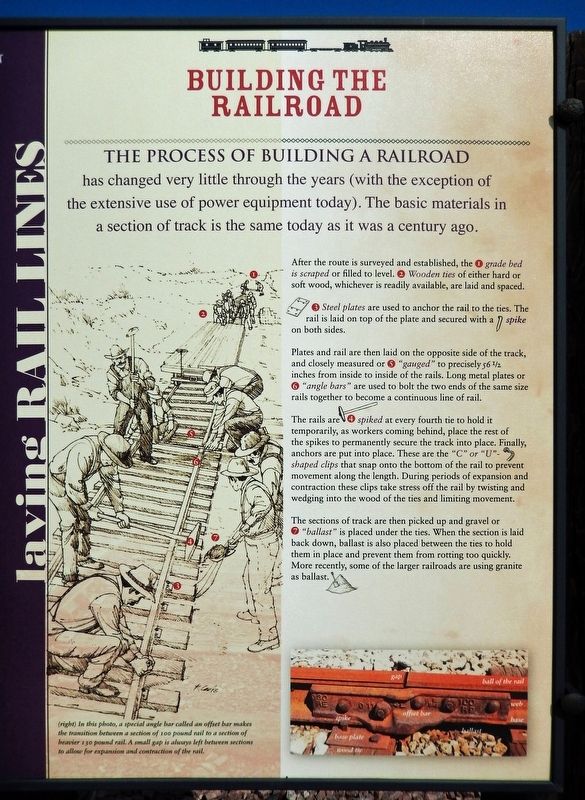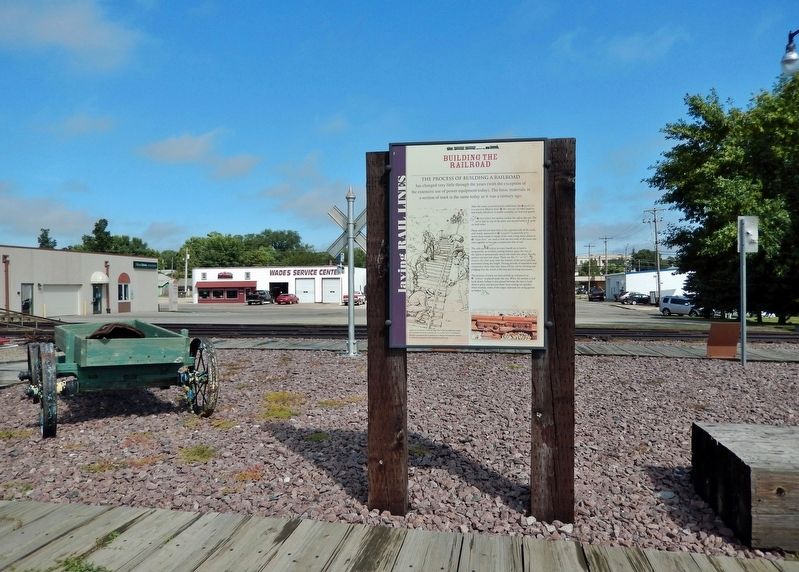Valley City in Barnes County, North Dakota — The American Midwest (Upper Plains)
Building the Railroad
Living Rail Lines
The process of building a railroad has changed very little through the years (with the exception of the extensive use of power equipment today). The basic materials in a section of track is the same today as it was a century ago.
After the route is surveyed and established, the [1] grade bed is scraped or filled to level. [2] Wooden ties of either hard or soft wood, whichever is readily available, are laid and spaced.
[3] Steel plates are used to anchor the rail to the ties. The rail is laid on top of the plate and secured with a spike on both sides.
Plates and rail are then laid on the opposite side of the track, and closely measured or [5] "gauged" to precisely 56˝ inches from inside to inside of the rails. Long metal plates or [6] "angle bars" are used to bolt the two ends of the same size rails together to become a continuous line of rail.
The rails are [4] "spiked" at every fourth tie to hold it temporarily, as workers coming behind, place the rest of the spikes to permanently secure the track into place. Finally, anchors are put into place. These are the "C" or "U"-shaped clips that snap onto the bottom of the rail to prevent movement along the length. During periods of expansion and contraction these clips take stress off the rail by twisting and wedging into the wood of the ties and limiting movement.
The sections of track are then picked up and gravel or [7] "ballast" is placed under the ties. When the section is laid back down, ballast is also placed between the ties to hold them in place and prevent them from rotting too quickly. More recently, some of the larger railroads are using granite as ballast.
[photo caption]
• In this photo, a special angle bar called an offset bar makes the transition between a section of 100 pound rail to a section of heavier 130 pound rail. A small gap is always left between sections to allow for expansion and contraction of the rail.
Topics. This historical marker is listed in this topic list: Railroads & Streetcars.
Location. 46° 55.418′ N, 98° 0.371′ W. Marker is in Valley City, North Dakota, in Barnes County. Marker can be reached from West Main Street (Business U.S. 10/52) 0.1 miles west of Central Avenue North (County Highway 21), on the right when traveling west. The marker is located on the Rosebud Visitor Center grounds. Touch for map. Marker is at or near this postal address: 250 West Main Street, Valley City ND 58072, United States of America. Touch for directions.
Other nearby markers. At least 8 other markers are within walking distance of this marker. Sun Kink Rail (here, next to this marker); 136 Lb. Rail (here, next to this marker); 90 Lb. Rail (here, next to this marker); 66 Lb. Rail (here, next to this marker); Rail Lines (a few steps from this marker); Wood Beam (a few steps from this marker); Valley City Street & Interurban Railroad (a few steps from this marker); Rosebud Visitor Center Along the Byway (within shouting distance of this marker). Touch for a list and map of all markers in Valley City.
Related markers. Click here for a list of markers that are related to this marker. Rosebud Visitor Center Railroad History Exhibit
Credits. This page was last revised on March 11, 2024. It was originally submitted on March 7, 2024, by Cosmos Mariner of Cape Canaveral, Florida. This page has been viewed 48 times since then. Photos: 1, 2. submitted on March 9, 2024, by Cosmos Mariner of Cape Canaveral, Florida.

